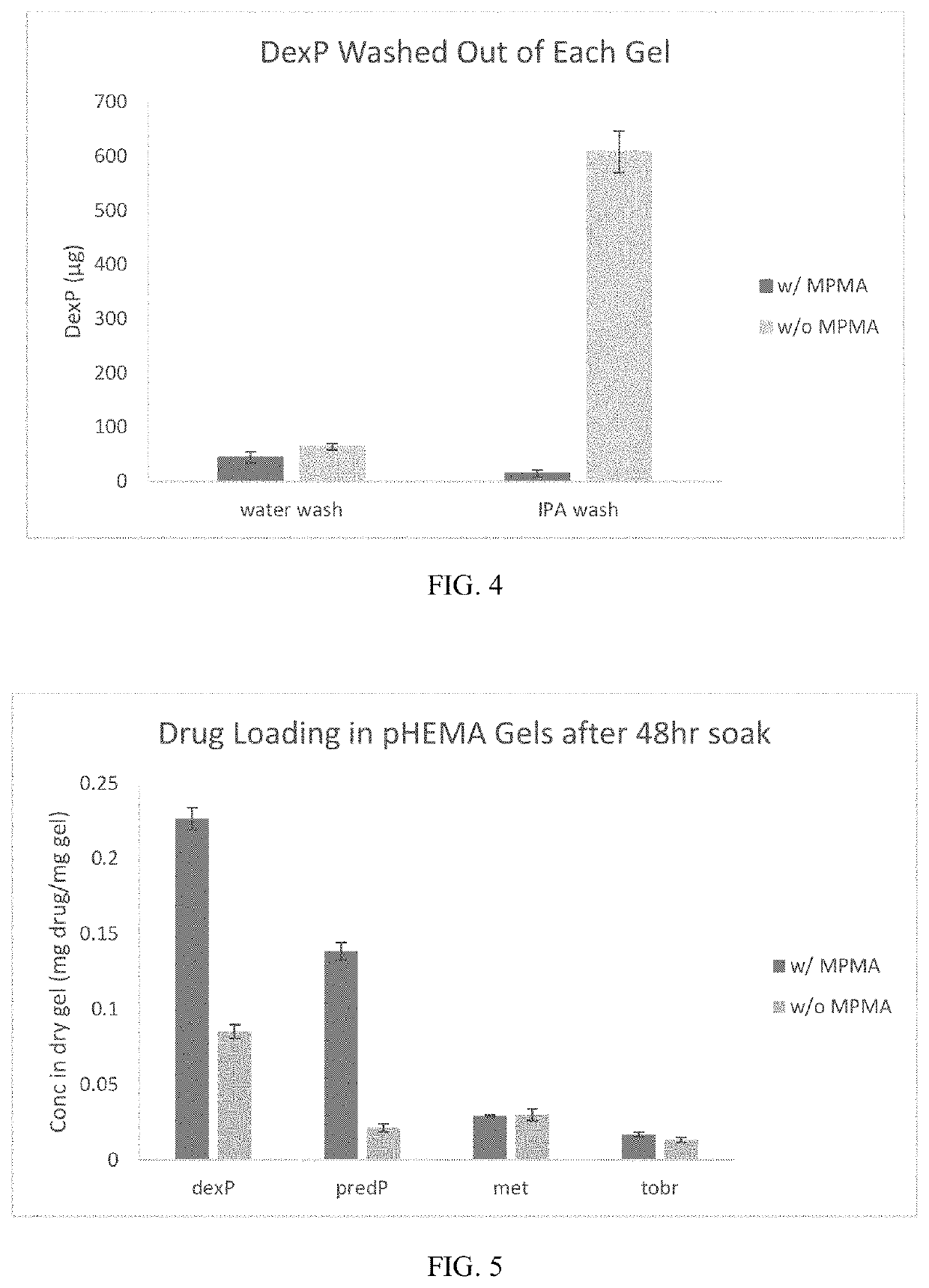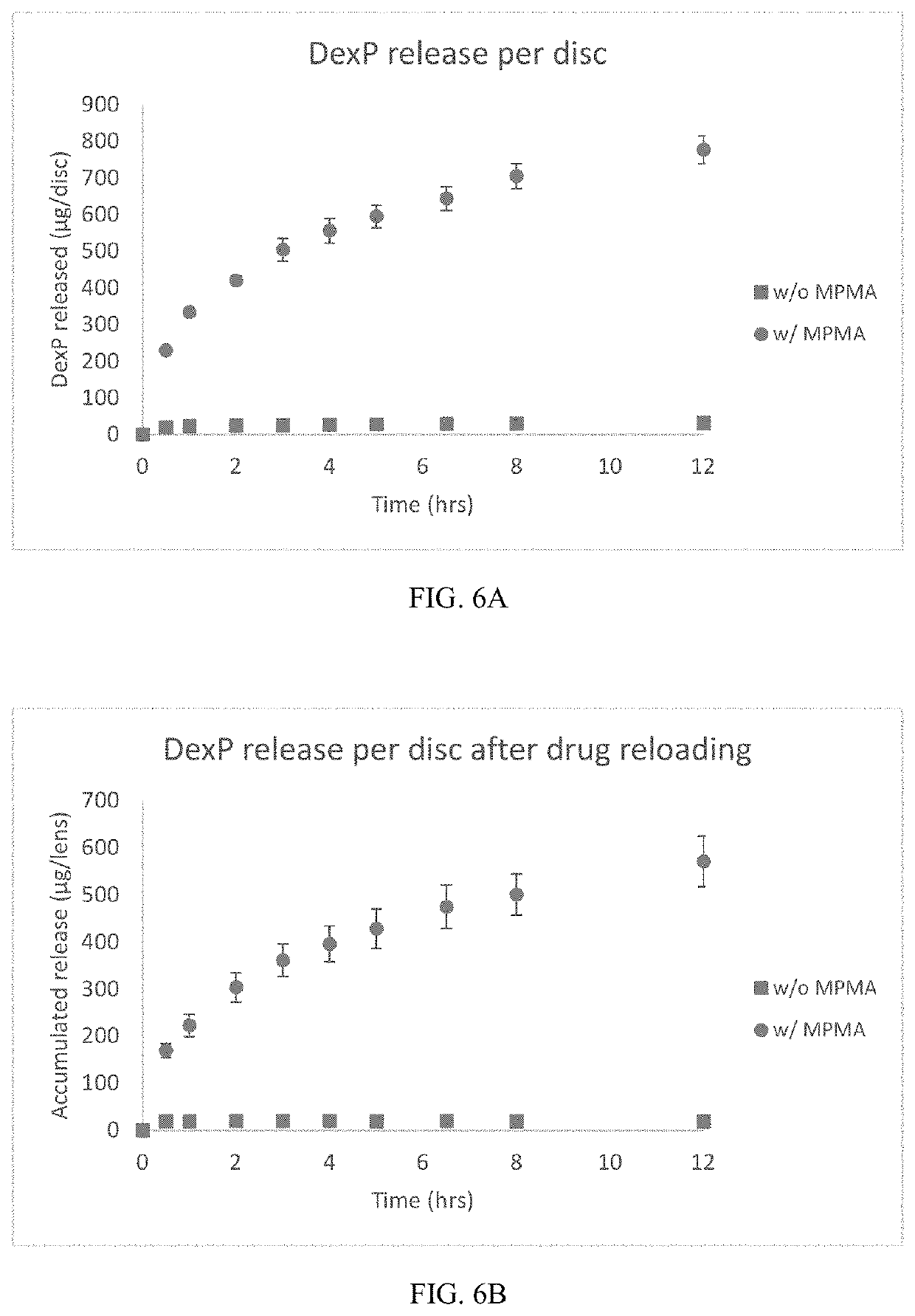Compositions and methods for treating ocular disease by contact lens mediated drug delivery
a technology of contact lens and therapeutic agent, which is applied in the field of compositions and methods for treating ocular diseases by contact lens mediated delivery of therapeutic agent, can solve problems such as eye damage, and achieve the effect of high loading capacity
- Summary
- Abstract
- Description
- Claims
- Application Information
AI Technical Summary
Benefits of technology
Problems solved by technology
Method used
Image
Examples
example 1
Formation
[0072]Various formulations of soft contact lens materials (hydrogels) were made with 3-(N-morpholino)propyl methacrylate (MPMA) as the monomer to aid with loading and release of drug. The formulations were either silicone-based or HEMA-based, and varied the concentration of MPMA (0-20%), photoinitiator (0.4-3%), and dexamethasone phosphate (0-5%). The final concentration of components of some exemplary formulations are shown in Table 1. For each formulation, components were mixed in the presence of an alcohol (methanol, ethanol, and / or hexanol) and transferred to a prepared UV-transparent polyester mold (52 mm×57 mm, thickness of 0.25 or 0.5 mm). The mold was then exposed to UV light (365 nm) for 5 minutes on each side to crosslink the material and form a hydrogel.
TABLE 1Components of various formulations of soft contact lens hydrogel materials made with MPMAmonomer. Amounts of components are listed as w / w % in the final crosslinked material. Component# 1# 2# 3# 4# 5# 6Lotr...
example 2
Properties of Hydrogels
[0075]Soft contact lens hydrogels were made using formulations 2 and 5 in Table 1, which have the same components except that #2 incorporates MPMA and #5 does not, to determine any effects of the monomer on the elastic modulus and maximum strength of the hydrogels. For this tensile testing, hydrogels were cut into dumbbell-shaped pieces (gauge area 3 mm×12.5 mm), placed in the grips of an Instron 4401 with 50N load cell, and extended (10 mm / min) until breaking. Formulations 1, 2, 4, 5, and 6 from Table 1 were additionally used to determine water content of the hydrogels. To determine equilibrium water content, 8 mm diameter discs of the hydrogels were cut and placed in DI water for at least 12 hours, blotted with a Kimwipe to remove excess fluid, and weighed. The gel pieces were then dried in a vacuum oven for at least 24 hours and re-weighed. The equilibrium water content was then determined as ([wet weight]−[dry weight]) / [wet weight]×100%.
[0076]As seen in FI...
example 3
ing Drug into Hydrogels
[0077]Soft contact lens hydrogels were made using formulation 4 in Table 1, wherein dexP was incorporated into the formulation prior to crosslinking to form the hydrogel. Hydrogels were made with and without the MPMA monomer to determine whether the MPMA would have a beneficial effect on keeping the dexP in the hydrogel during extraction washes of water and alcohol, as these extraction washes are typically done for soft contact lens hydrogel materials post-crosslinking to remove any unreacted / uncrosslinked components. Hydrogels were placed in deionized (DI) water for 35 minutes at 37° C. / 200 rpm, followed by 3 times in isopropyl alcohol for 25 minutes each at 37° C. / 200 rpm, then 2 additional times in DI water for 25 minutes each. The DI water washes and alcohol washes were collected and the amount of dexP was determined using HPLC-UV. As seen in FIG. 4, very little of the incorporated dexP was removed from the hydrogels during both the water and alcohol washe...
PUM
| Property | Measurement | Unit |
|---|---|---|
| Fraction | aaaaa | aaaaa |
| Fraction | aaaaa | aaaaa |
| Time | aaaaa | aaaaa |
Abstract
Description
Claims
Application Information
 Login to View More
Login to View More - R&D
- Intellectual Property
- Life Sciences
- Materials
- Tech Scout
- Unparalleled Data Quality
- Higher Quality Content
- 60% Fewer Hallucinations
Browse by: Latest US Patents, China's latest patents, Technical Efficacy Thesaurus, Application Domain, Technology Topic, Popular Technical Reports.
© 2025 PatSnap. All rights reserved.Legal|Privacy policy|Modern Slavery Act Transparency Statement|Sitemap|About US| Contact US: help@patsnap.com



